Accounting for Managers: Free Cash Flow Analysis for Two Companies
VerifiedAdded on 2020/05/28
|7
|815
|36
Homework Assignment
AI Summary
This assignment analyzes the free cash flow (FCF) and valuation of General Mills, Inc. and Kimberly-Clark Corporation. The analysis for General Mills focuses on calculating FCF, discounted cash flow, and its impact on share value, considering different growth rates. The assignment also explores how the free cash flow can be used to detect the value per share. For Kimberly-Clark, the assignment presents two methods for calculating FCF from operations, and how these calculations can be used to determine the company's financial stability and net payouts to shareholders. The document references several academic sources to support the analysis. The assignment demonstrates the application of financial accounting principles to assess company performance and make informed investment decisions.
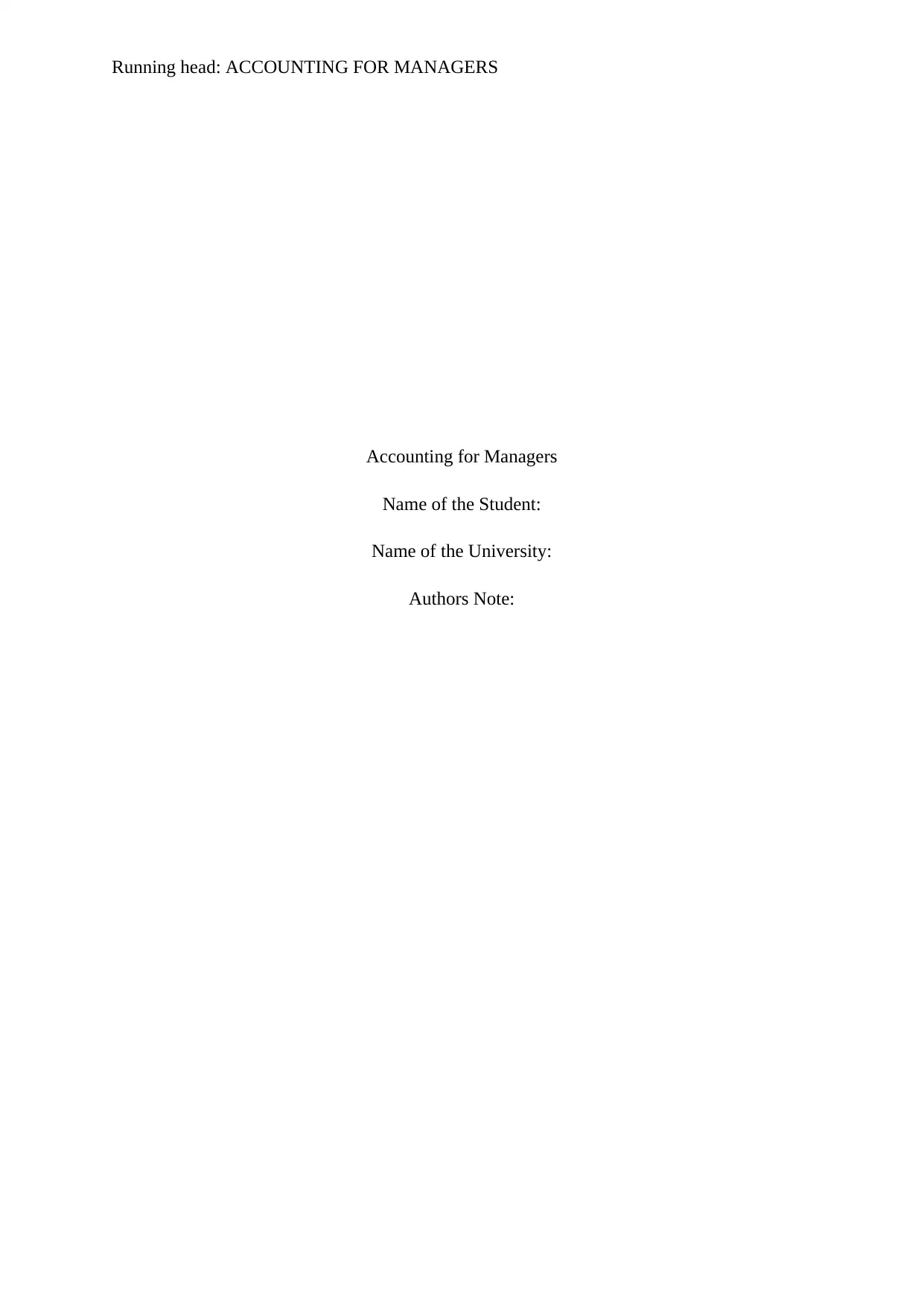
Running head: ACCOUNTING FOR MANAGERS
Accounting for Managers
Name of the Student:
Name of the University:
Authors Note:
Accounting for Managers
Name of the Student:
Name of the University:
Authors Note:
Paraphrase This Document
Need a fresh take? Get an instant paraphrase of this document with our AI Paraphraser
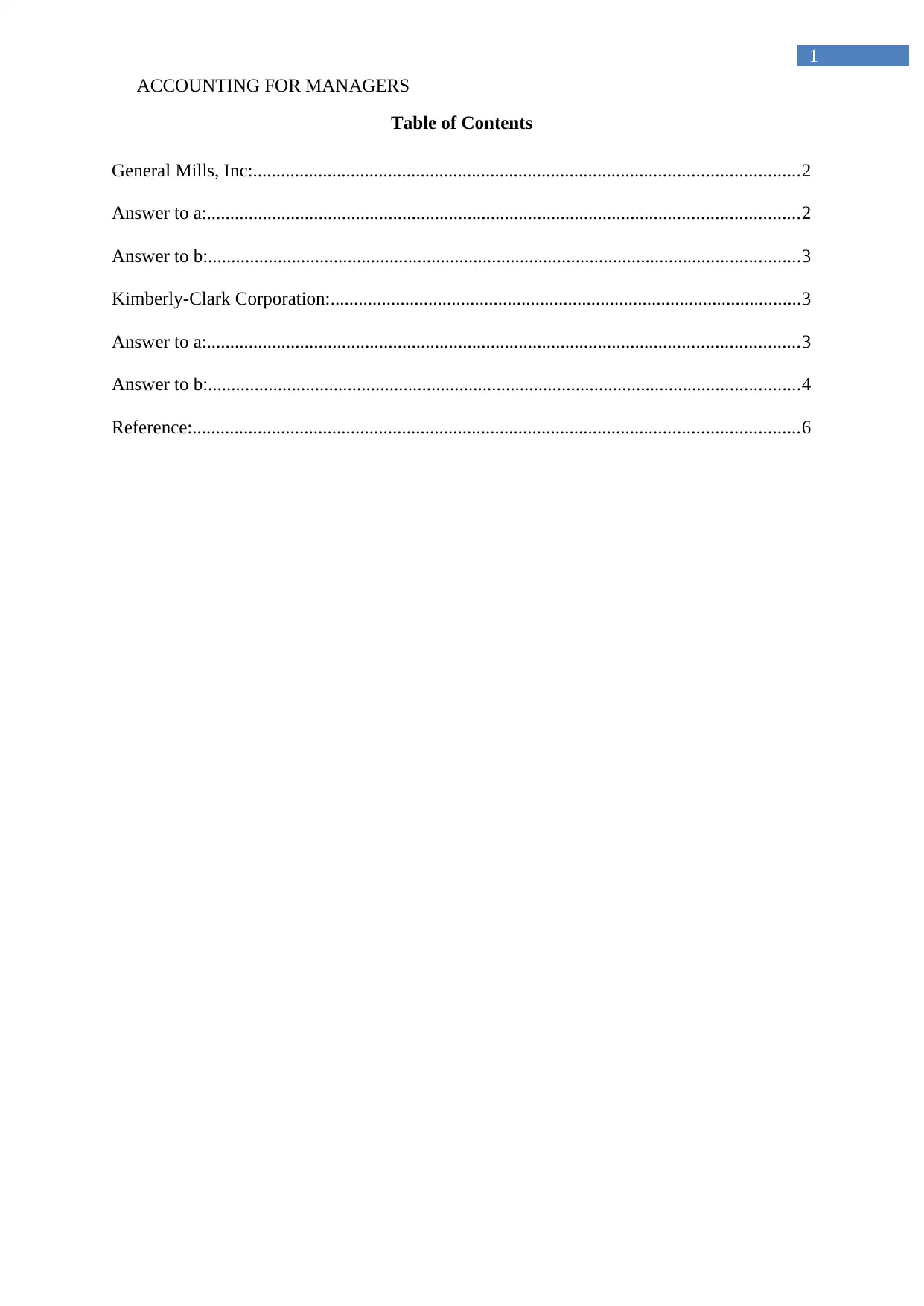
ACCOUNTING FOR MANAGERS
1
Table of Contents
General Mills, Inc:.....................................................................................................................2
Answer to a:...............................................................................................................................2
Answer to b:...............................................................................................................................3
Kimberly-Clark Corporation:.....................................................................................................3
Answer to a:...............................................................................................................................3
Answer to b:...............................................................................................................................4
Reference:..................................................................................................................................6
1
Table of Contents
General Mills, Inc:.....................................................................................................................2
Answer to a:...............................................................................................................................2
Answer to b:...............................................................................................................................3
Kimberly-Clark Corporation:.....................................................................................................3
Answer to a:...............................................................................................................................3
Answer to b:...............................................................................................................................4
Reference:..................................................................................................................................6
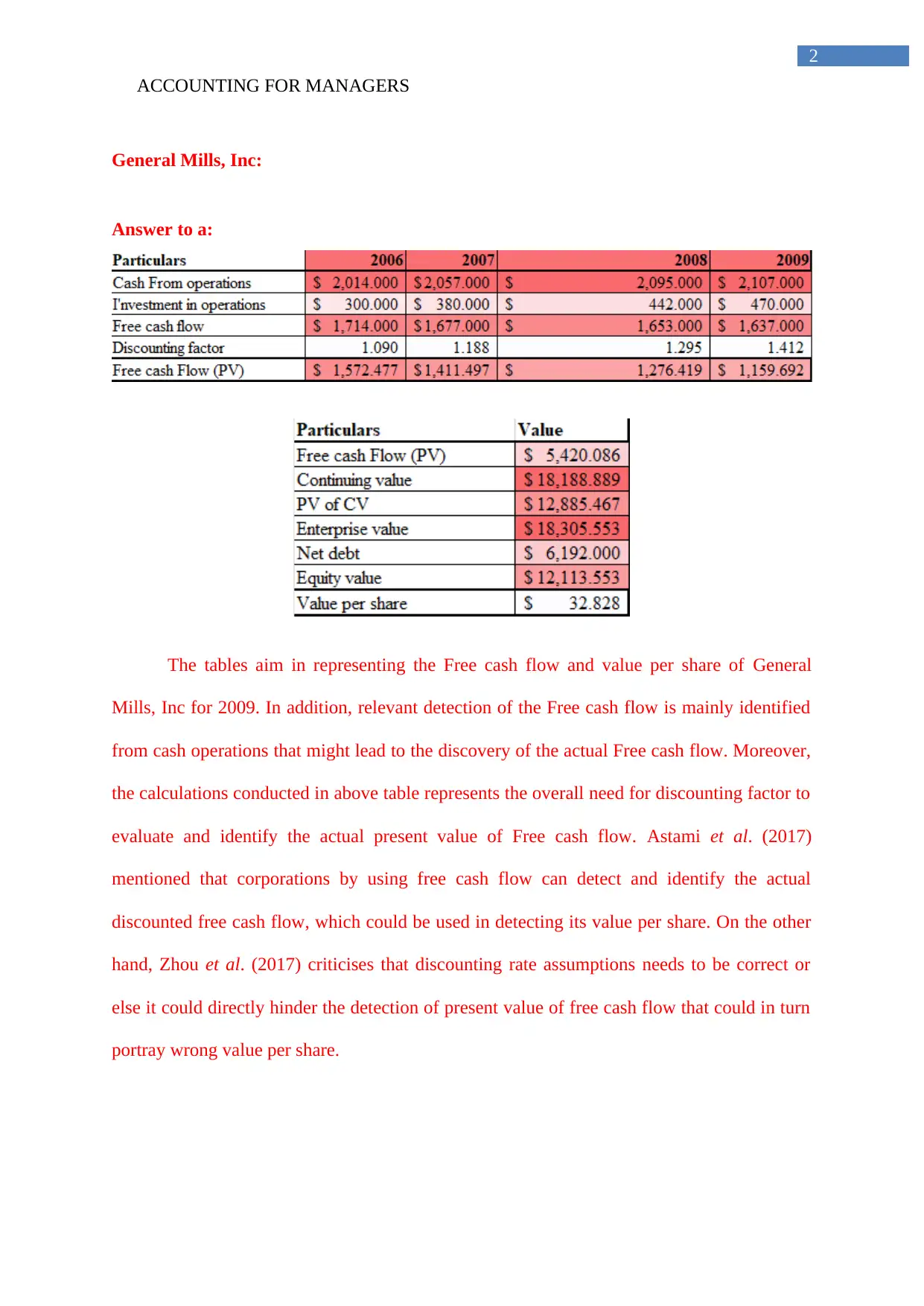
ACCOUNTING FOR MANAGERS
2
General Mills, Inc:
Answer to a:
The tables aim in representing the Free cash flow and value per share of General
Mills, Inc for 2009. In addition, relevant detection of the Free cash flow is mainly identified
from cash operations that might lead to the discovery of the actual Free cash flow. Moreover,
the calculations conducted in above table represents the overall need for discounting factor to
evaluate and identify the actual present value of Free cash flow. Astami et al. (2017)
mentioned that corporations by using free cash flow can detect and identify the actual
discounted free cash flow, which could be used in detecting its value per share. On the other
hand, Zhou et al. (2017) criticises that discounting rate assumptions needs to be correct or
else it could directly hinder the detection of present value of free cash flow that could in turn
portray wrong value per share.
2
General Mills, Inc:
Answer to a:
The tables aim in representing the Free cash flow and value per share of General
Mills, Inc for 2009. In addition, relevant detection of the Free cash flow is mainly identified
from cash operations that might lead to the discovery of the actual Free cash flow. Moreover,
the calculations conducted in above table represents the overall need for discounting factor to
evaluate and identify the actual present value of Free cash flow. Astami et al. (2017)
mentioned that corporations by using free cash flow can detect and identify the actual
discounted free cash flow, which could be used in detecting its value per share. On the other
hand, Zhou et al. (2017) criticises that discounting rate assumptions needs to be correct or
else it could directly hinder the detection of present value of free cash flow that could in turn
portray wrong value per share.
⊘ This is a preview!⊘
Do you want full access?
Subscribe today to unlock all pages.

Trusted by 1+ million students worldwide
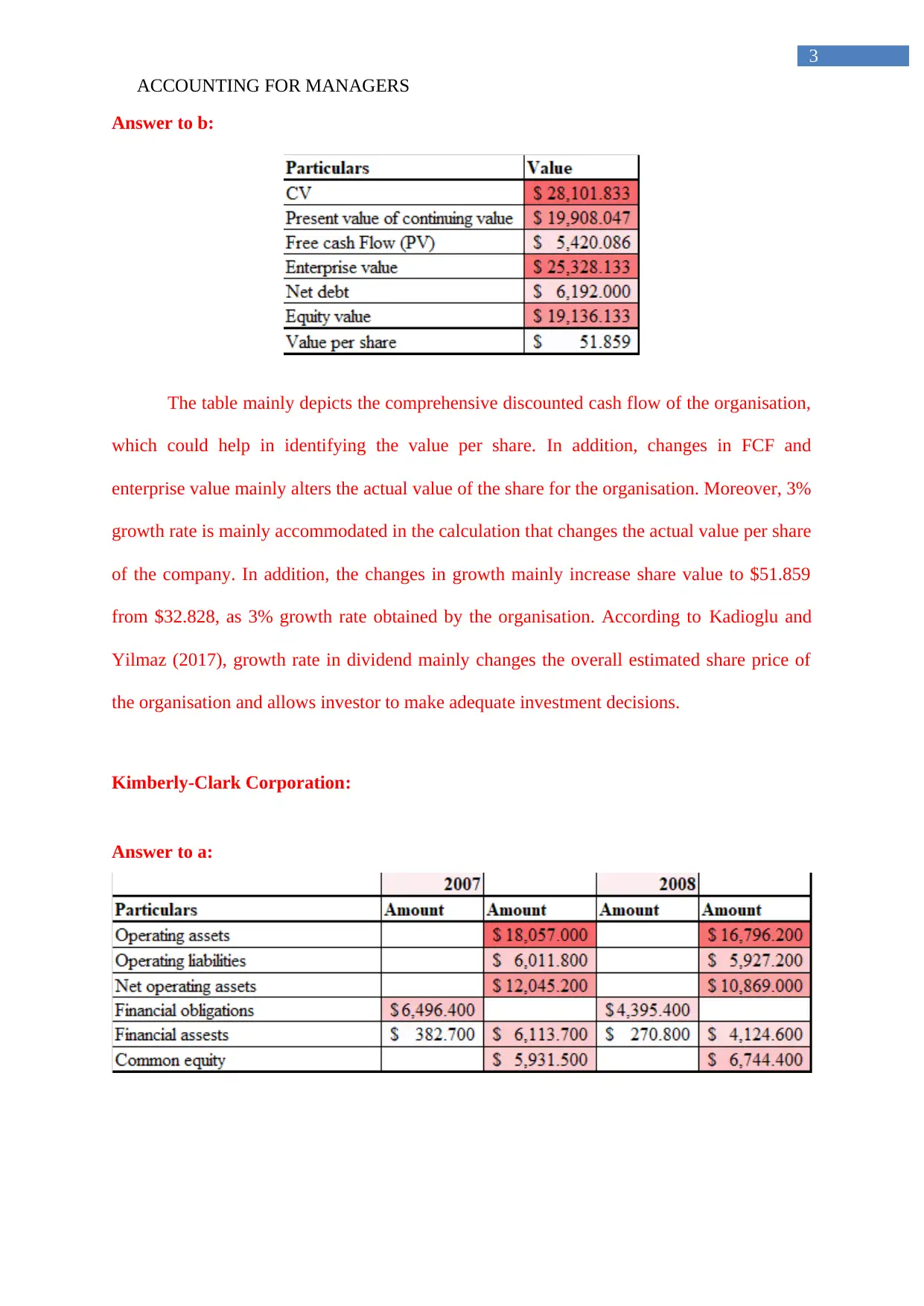
ACCOUNTING FOR MANAGERS
3
Answer to b:
The table mainly depicts the comprehensive discounted cash flow of the organisation,
which could help in identifying the value per share. In addition, changes in FCF and
enterprise value mainly alters the actual value of the share for the organisation. Moreover, 3%
growth rate is mainly accommodated in the calculation that changes the actual value per share
of the company. In addition, the changes in growth mainly increase share value to $51.859
from $32.828, as 3% growth rate obtained by the organisation. According to Kadioglu and
Yilmaz (2017), growth rate in dividend mainly changes the overall estimated share price of
the organisation and allows investor to make adequate investment decisions.
Kimberly-Clark Corporation:
Answer to a:
3
Answer to b:
The table mainly depicts the comprehensive discounted cash flow of the organisation,
which could help in identifying the value per share. In addition, changes in FCF and
enterprise value mainly alters the actual value of the share for the organisation. Moreover, 3%
growth rate is mainly accommodated in the calculation that changes the actual value per share
of the company. In addition, the changes in growth mainly increase share value to $51.859
from $32.828, as 3% growth rate obtained by the organisation. According to Kadioglu and
Yilmaz (2017), growth rate in dividend mainly changes the overall estimated share price of
the organisation and allows investor to make adequate investment decisions.
Kimberly-Clark Corporation:
Answer to a:
Paraphrase This Document
Need a fresh take? Get an instant paraphrase of this document with our AI Paraphraser
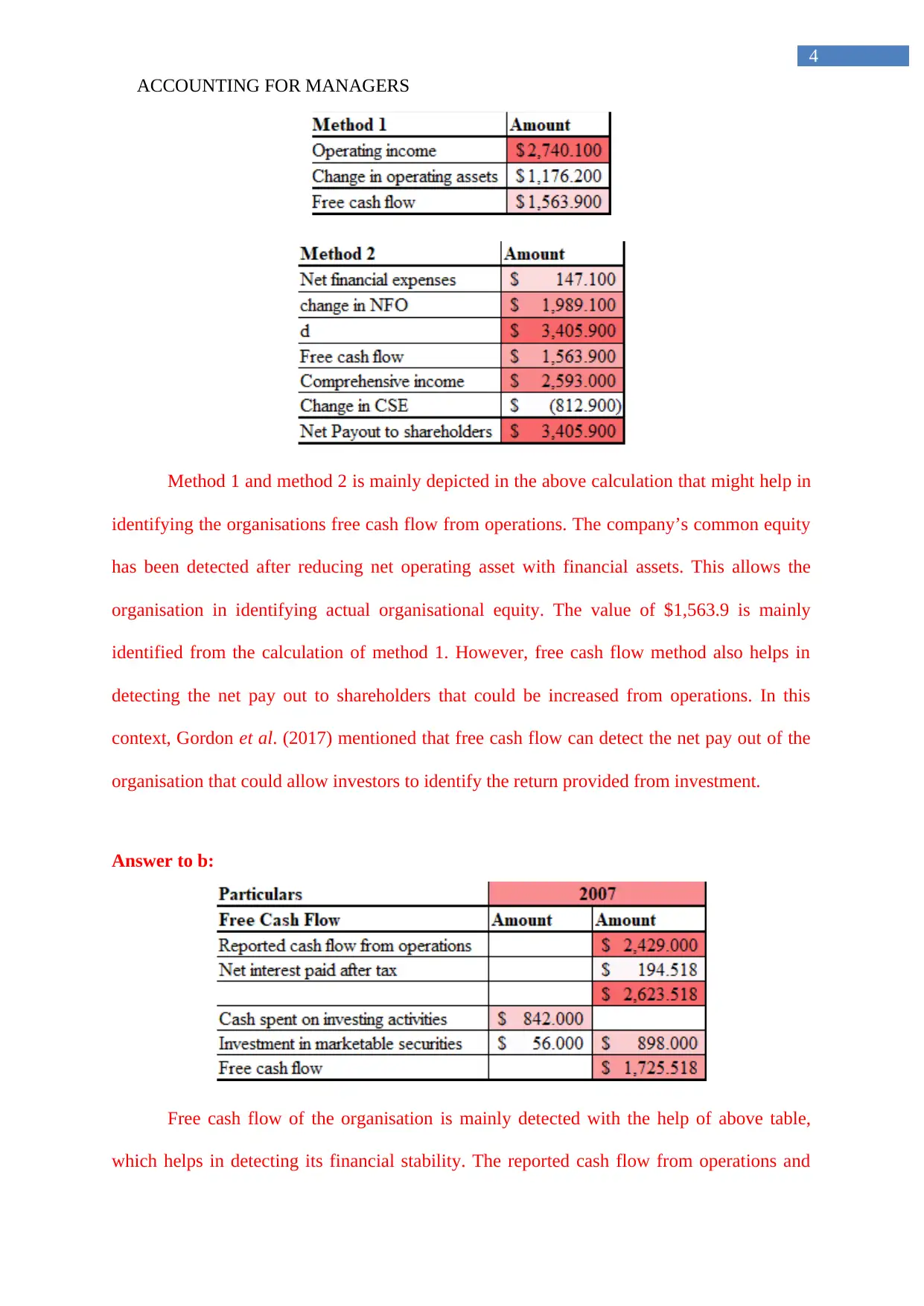
ACCOUNTING FOR MANAGERS
4
Method 1 and method 2 is mainly depicted in the above calculation that might help in
identifying the organisations free cash flow from operations. The company’s common equity
has been detected after reducing net operating asset with financial assets. This allows the
organisation in identifying actual organisational equity. The value of $1,563.9 is mainly
identified from the calculation of method 1. However, free cash flow method also helps in
detecting the net pay out to shareholders that could be increased from operations. In this
context, Gordon et al. (2017) mentioned that free cash flow can detect the net pay out of the
organisation that could allow investors to identify the return provided from investment.
Answer to b:
Free cash flow of the organisation is mainly detected with the help of above table,
which helps in detecting its financial stability. The reported cash flow from operations and
4
Method 1 and method 2 is mainly depicted in the above calculation that might help in
identifying the organisations free cash flow from operations. The company’s common equity
has been detected after reducing net operating asset with financial assets. This allows the
organisation in identifying actual organisational equity. The value of $1,563.9 is mainly
identified from the calculation of method 1. However, free cash flow method also helps in
detecting the net pay out to shareholders that could be increased from operations. In this
context, Gordon et al. (2017) mentioned that free cash flow can detect the net pay out of the
organisation that could allow investors to identify the return provided from investment.
Answer to b:
Free cash flow of the organisation is mainly detected with the help of above table,
which helps in detecting its financial stability. The reported cash flow from operations and

ACCOUNTING FOR MANAGERS
5
net interest paid after tax sums up to $2,623.518. Moreover, investment in marketing
securities and cash spending on investing activities are summed and detected from the period
value to identify the actual free cash flow of the company. The Free cash flow is mainly
calculated at the levels of $1,725.518, which could allow investors in identifying financial
position of the organisation. Kadioglu and Yilmaz (2017) mentioned that detection of the
overall free cash flow is essential for the investors in identifying financial stability of the
organisation.
5
net interest paid after tax sums up to $2,623.518. Moreover, investment in marketing
securities and cash spending on investing activities are summed and detected from the period
value to identify the actual free cash flow of the company. The Free cash flow is mainly
calculated at the levels of $1,725.518, which could allow investors in identifying financial
position of the organisation. Kadioglu and Yilmaz (2017) mentioned that detection of the
overall free cash flow is essential for the investors in identifying financial stability of the
organisation.
⊘ This is a preview!⊘
Do you want full access?
Subscribe today to unlock all pages.

Trusted by 1+ million students worldwide
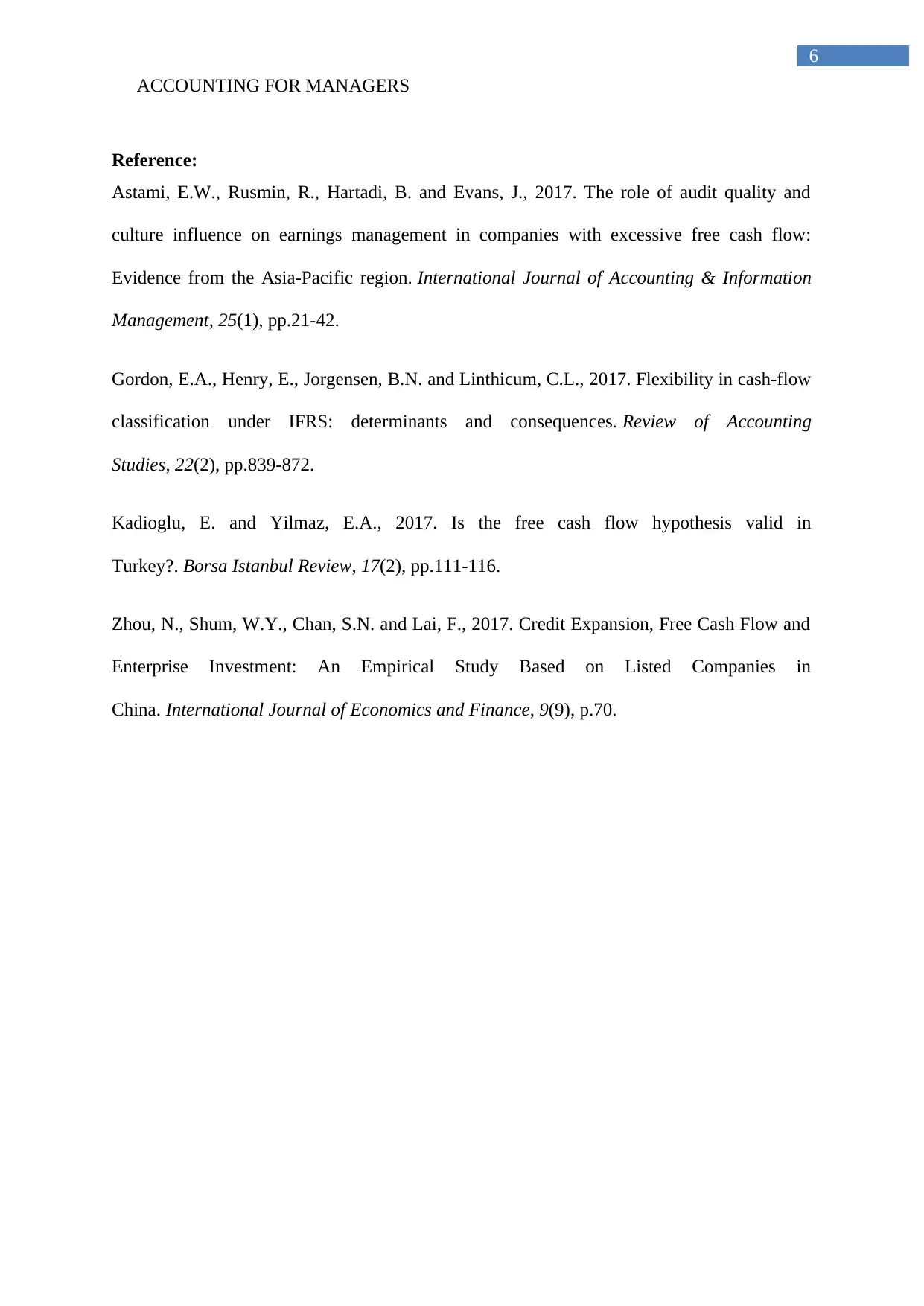
ACCOUNTING FOR MANAGERS
6
Reference:
Astami, E.W., Rusmin, R., Hartadi, B. and Evans, J., 2017. The role of audit quality and
culture influence on earnings management in companies with excessive free cash flow:
Evidence from the Asia-Pacific region. International Journal of Accounting & Information
Management, 25(1), pp.21-42.
Gordon, E.A., Henry, E., Jorgensen, B.N. and Linthicum, C.L., 2017. Flexibility in cash-flow
classification under IFRS: determinants and consequences. Review of Accounting
Studies, 22(2), pp.839-872.
Kadioglu, E. and Yilmaz, E.A., 2017. Is the free cash flow hypothesis valid in
Turkey?. Borsa Istanbul Review, 17(2), pp.111-116.
Zhou, N., Shum, W.Y., Chan, S.N. and Lai, F., 2017. Credit Expansion, Free Cash Flow and
Enterprise Investment: An Empirical Study Based on Listed Companies in
China. International Journal of Economics and Finance, 9(9), p.70.
6
Reference:
Astami, E.W., Rusmin, R., Hartadi, B. and Evans, J., 2017. The role of audit quality and
culture influence on earnings management in companies with excessive free cash flow:
Evidence from the Asia-Pacific region. International Journal of Accounting & Information
Management, 25(1), pp.21-42.
Gordon, E.A., Henry, E., Jorgensen, B.N. and Linthicum, C.L., 2017. Flexibility in cash-flow
classification under IFRS: determinants and consequences. Review of Accounting
Studies, 22(2), pp.839-872.
Kadioglu, E. and Yilmaz, E.A., 2017. Is the free cash flow hypothesis valid in
Turkey?. Borsa Istanbul Review, 17(2), pp.111-116.
Zhou, N., Shum, W.Y., Chan, S.N. and Lai, F., 2017. Credit Expansion, Free Cash Flow and
Enterprise Investment: An Empirical Study Based on Listed Companies in
China. International Journal of Economics and Finance, 9(9), p.70.
1 out of 7
Related Documents
Your All-in-One AI-Powered Toolkit for Academic Success.
+13062052269
info@desklib.com
Available 24*7 on WhatsApp / Email
![[object Object]](/_next/static/media/star-bottom.7253800d.svg)
Unlock your academic potential
Copyright © 2020–2025 A2Z Services. All Rights Reserved. Developed and managed by ZUCOL.





